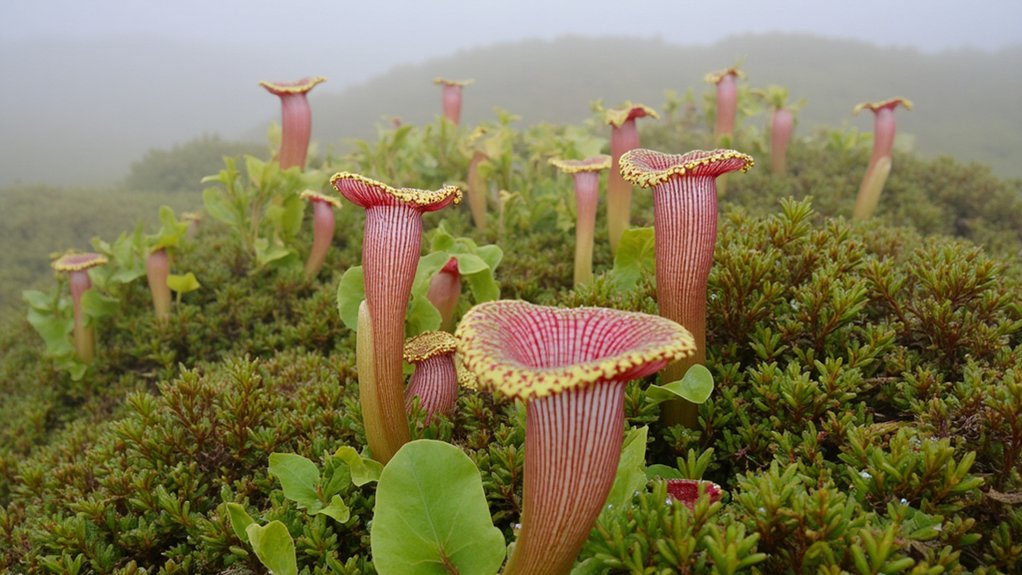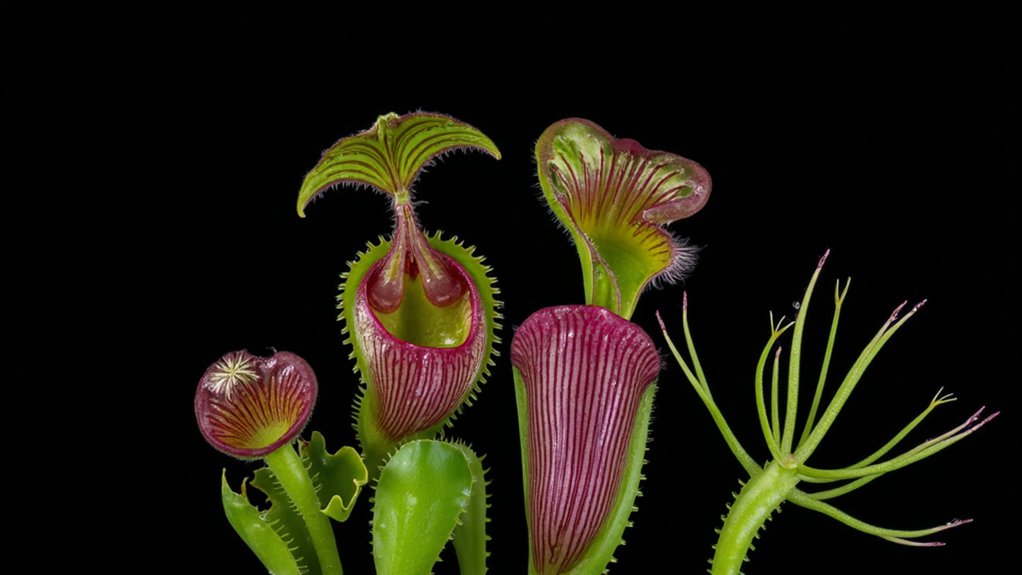Just when you’re thinking plants can’t get any stranger, you’ll discover that some have evolved to become skilled insect hunters. You’ve probably seen Venus flytraps snap shut on unsuspecting flies, but that’s just one of five distinct trapping mechanisms these botanical predators have developed over millions of years. Their remarkable journey from ordinary plants to skilled hunters began in nutrient-poor environments, where traditional photosynthesis wasn’t quite enough to survive.
Contents
- 1 The Origins of Plant Carnivory in Nutrient-Poor Soils
- 2 Five Major Types of Trapping Mechanisms
- 3 Chemical Adaptations for Prey Digestion
- 4 Notable Species and Their Global Distribution
- 5 The Evolutionary Timeline of Carnivorous Plants
- 6 Survival Advantages in Competitive Ecosystems
- 7 Conservation Status and Environmental Threats
The Origins of Plant Carnivory in Nutrient-Poor Soils

While most plants obtain nutrients through their roots, carnivorous plants evolved a fascinating alternative strategy in environments where essential elements were scarce. You’ll find these clever species thriving in bogs, swamps, and other nutrient-poor soils where nitrogen and phosphorus are hard to come by.
Over millions of years, these plants developed specialized leaves that can trap and digest insects to supplement their nutritional needs. You’d be amazed to learn that some species, like the Venus flytrap, can snap shut in less than a second when triggered, while others use sticky surfaces or liquid-filled pitfall traps to capture their prey.
Five Major Types of Trapping Mechanisms

Although scientists have identified several ways carnivorous plants catch their prey, there are five primary trapping mechanisms you’ll encounter most often in nature. You’ll find snap traps, like Venus flytraps, that quickly shut on insects, and pitfall traps, such as pitcher plants, that use slippery surfaces to capture prey in digestive fluid.
There’s also the adhesive trap method, where sundews use sticky droplets, and the suction trap that bladderworts employ underwater. The fifth type, the lobster-pot trap, features inward-pointing hairs that let insects enter but prevent their escape, like those in corkscrew plants.
Chemical Adaptations for Prey Digestion

Since carnivorous plants can’t chase down their meals, they’ve evolved sophisticated digestive enzymes to break down prey trapped in their specialized structures. You’ll find these plants secreting a complex mixture of acids, proteases, phosphatases, and nucleases to dissolve their insect meals.
In pitcher plants, you can observe a liquid pool containing digestive enzymes that break down prey within 6-12 hours. Venus flytraps, meanwhile, pump enzymes directly into their sealed traps, where digestion takes 5-12 days, depending on the prey’s size.
The enzymes work similarly to those in your stomach, converting proteins into amino acids and other nutrients the plant can absorb.
Notable Species and Their Global Distribution
Because carnivorous plants have adapted to diverse environments worldwide, you’ll find fascinating species on every continent except Antarctica. Venus flytraps are native to the Carolina coastal plains, while pitcher plants thrive in Southeast Asia’s rainforests.
You’ll discover sundews in Australia’s outback, where they capture prey with sticky tentacles. The waterwheel plant, found in Europe and Asia, snaps shut underwater in less than 20 milliseconds to catch aquatic insects.
In South America, you can spot the giant montane pitcher plant, which grows up to 1.5 meters tall and sometimes traps small mammals in its specialized leaves.
The Evolutionary Timeline of Carnivorous Plants
The remarkable adaptations we see in modern carnivorous plants didn’t appear overnight – they’re the result of millions of years of evolution. Scientists estimate their origins date back roughly 70 million years ago, during the late Cretaceous period when flowering plants were diversifying rapidly.
You’ll find that carnivorous traits evolved independently in different plant families at least six separate times. The Venus flytrap, for instance, shares a common ancestor with sundews from about 65 million years ago. Their sticky leaves gradually became more specialized, developing into the sophisticated snap-traps you can observe today.
Survival Advantages in Competitive Ecosystems
In nutrient-poor environments where most plants struggle to survive, carnivorous species have evolved remarkable competitive advantages. You’ll find these clever plants thriving in bogs and wetlands where nitrogen and phosphorus are scarce, as they’ve developed specialized traps to supplement their diet with insect protein.
When you examine their hunting strategies, you’ll notice they’re incredibly efficient. Venus flytraps snap shut in less than a second, while pitcher plants create slippery death tubes filled with digestive enzymes. Sundews use sticky tentacles that curl around prey, and bladderworts create vacuum-powered traps underwater that catch tiny aquatic creatures.
Conservation Status and Environmental Threats
Many carnivorous plant species face critical survival challenges, with population declines accelerating since the 1950s. You’ll find these fascinating plants increasingly threatened by habitat loss, as wetlands are drained for agriculture and development. Climate change has disrupted their delicate growing conditions, while illegal collection continues to decimate wild populations.
If you’re interested in helping preserve these species, you can support conservation efforts through verified organizations. You’ll also make an impact by avoiding wild-collected specimens and purchasing only nursery-grown plants. These steps help guarantee these remarkable predatory plants don’t vanish from Earth’s ecosystems.
